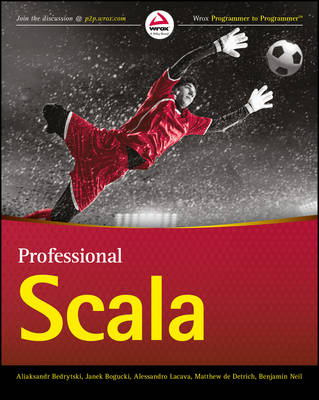
Professional Scala
John Wiley & Sons Inc (Verlag)
978-1-119-26722-5 (ISBN)
- Titel ist leider vergriffen;
keine Neuauflage - Artikel merken
Java–compliant with functional programming properties, Scala′s popularity is growing quickly especially in the rapidly expanding areas of big data and cluster computing. This book explains everything professional programmers need to start using Scala and its main tools quickly and effectively.
Master Scala syntax, the SBT interactive build tool, and the REPL workflow
Explore functional design patterns, concurrency, and testing
Work effectively with Maven, Scaladoc, Scala.js, and more
Dive into the advanced type system
Find out about Scala.js
A working knowledge of Scala puts you in demand. As both the language and applications expand, so do the opportunities for experienced Scala programmers and many positions are going unfilled. Twitter, Comcast, Netflix, and other major enterprises across industries are using Scala every day, in a number of different applications and capacities. Professional Scala helps you update your skills quickly to start advancing your career.
Aliaksandr Bedrytski is a Big Data engineer at Worldline France. Janek Bogucki is a Co–Founder of Inferess Inc., and Principal Consultant (Scala and Data Science) at Combination One. Alessandro Lacava is a lead designer and developer who specializes in functional programming and Scala. Matthew de Detrich is a Software Engineer at Zalando. Benjamin Neil is a Full Stack Engineer at AppThis LLC. Visit us at wrox.com where you have access to free code samples, Programmer to Programmer forums, and discussions on the latest happenings in the industry from around the world.
INTRODUCTION xv
CHAPTER 1: LANGUAGE FEATURES 1
Static Types and Type Inference 2
Implicit Parameters, Conversions, and Their Resolution 3
Case Class, Tuples, and Case Object 5
Abstract Class, Traits, and Sealed 6
Pattern Matching 8
Statements Are Expressions 9
String Interpolation 9
Scala Collections, immutable and mutable 10
For Comprehension 12
Packages, Companion Objects, Package Objects, and Scoping 13
AnyVal, AnyRef, Any, and the Type Hierarchy 16
Summary 17
CHAPTER 2: FUNCTIONAL PROGRAMMING 19
Immutability 20
Pure Functions 22
Recursion 23
Higher–Order Functions 26
Core Collection Methods 27
Methods Returning a Collection 29
Methods Returning a Value 31
Currying and Partially Applied Functions 32
Null Handling (Option) 34
Strict versus Non–Strict Initialization 35
Summary 36
CHAPTER 3: JAVA COMPATIBILITY 37
Scala and Java Collections 37
Interfaces and Traits 40
Scala/Java Enumerations 42
Summary 43
CHAPTER 4: SIMPLE BUILD TOOL 45
Basic Usage 46
Project Structure 47
Single Project 47
Scopes 49
Custom Tasks 50
Dependencies 50
Resolvers 51
Advanced Usage 52
Advanced Dependencies 53
Testing in the Console 55
Release Management 56
Deploying to Sonatype 56
Packaging with SBT–Native–Packager 58
Creating a Docker Image 59
Common SBT Commands 60
Useful Plugins 61
Summary 62
CHAPTER 5: MAVEN 63
Getting Started with Maven and Scala 64
Introducing scala–maven–plugin 67
Adding Library Dependencies 70
Using the REPL 71
Getting Help 72
Running Tests 72
Joint Compilation with Java 74
Accelerating Compilation with Zinc 76
Summary 77
CHAPTER 6: SCALA STYLE/LINT 79
Scala with Style 79
Scaliform 81
Scapegoat 82
WartRemover 82
Scoverage 84
Summary 84
CHAPTER 7: TESTING 85
ScalaTest 86
Unit Tests 87
Integration Testing 87
Data–Driven Tests 88
Performance Testing 89
Acceptance Testing 90
Mocks 92
Load Testing 93
Summary 94
CHAPTER 8: DOCUMENTING YOUR CODE WITH SCALADOC 95
Why Document Your Code? 96
Revealing the Benefi ts 96
Bookending the Continuum 96
Choosing What to Document 96
Scaladoc Structure 97
Overall Layout 97
Index Pane 98
Content Pane 100
Invoking the Scaladoc Tool 106
Wiki Syntax 108
Formatting with Inline Wiki Syntax 108
Structuring with Block Elements 110
Linking 113
Locating Scaladoc 117
Tagging 117
Everyday Tagging 117
Tagging for Groups 123
Advanced Tagging 125
Invoking scaladoc: Additional Options 132
Integrating Scaladoc Creation with Your Project 133
Configuring Maven 133
Configuring SBT 134
Publishing Scaladoc 134
Tables and CSS 136
Summary 138
CHAPTER 9: TYPE SYSTEM 139
What Is a Type System? 140
Static versus Dynamic Typing 140
What Static Type Systems Are Good For 141
What Dynamic Type Systems Are Good For 141
Scala s Unified Type System 141
Value Classes 143
Polymorphism 145
Subtype Polymorphism 145
Parametric Polymorphism 146
Ad Hoc Polymorphism 146
Bounds 149
Context Bounds 149
Upper and Lower Bounds 150
Variance 151
Other Niceties 155
Self–Type Annotations 155
Self–Recursive Types 158
Abstract Type Members 159
Dynamic Programming 161
Structural Types 161
Dynamic Trait 162
Summary 164
CHAPTER 10: ADVANCED FUNCTIONAL PROGRAMMING 165
Higher–Kinded Types 165
Functional Design Patterns 167
Functor 167
Applicative Functor 170
Monad 172
Semigroup 173
Monoid 174
Summary 176
CHAPTER 11: CONCURRENCY 179
Synchronize/Atomic Variables 181
Future Composition 184
Parallel Collections 187
Reactive Streams 192
STM 195
Actors (Akka) 198
Spark 200
Summary 202
CHAPTER 12: SCALA.JS 205
Scala.js and Its Design 205
Getting Started: Scala.js with SBT 206
Scala.js Peculiarities 210
Webjars and Dealing with the Frontend Ecosytem 211
Summary 213
INDEX 215
| Erscheinungsdatum | 30.07.2016 |
|---|---|
| Verlagsort | New York |
| Sprache | englisch |
| Maße | 187 x 232 mm |
| Gewicht | 414 g |
| Themenwelt | Mathematik / Informatik ► Informatik ► Datenbanken |
| Mathematik / Informatik ► Informatik ► Netzwerke | |
| Informatik ► Programmiersprachen / -werkzeuge ► Scala | |
| Mathematik / Informatik ► Informatik ► Software Entwicklung | |
| Informatik ► Weitere Themen ► Hardware | |
| ISBN-10 | 1-119-26722-6 / 1119267226 |
| ISBN-13 | 978-1-119-26722-5 / 9781119267225 |
| Zustand | Neuware |
| Haben Sie eine Frage zum Produkt? |